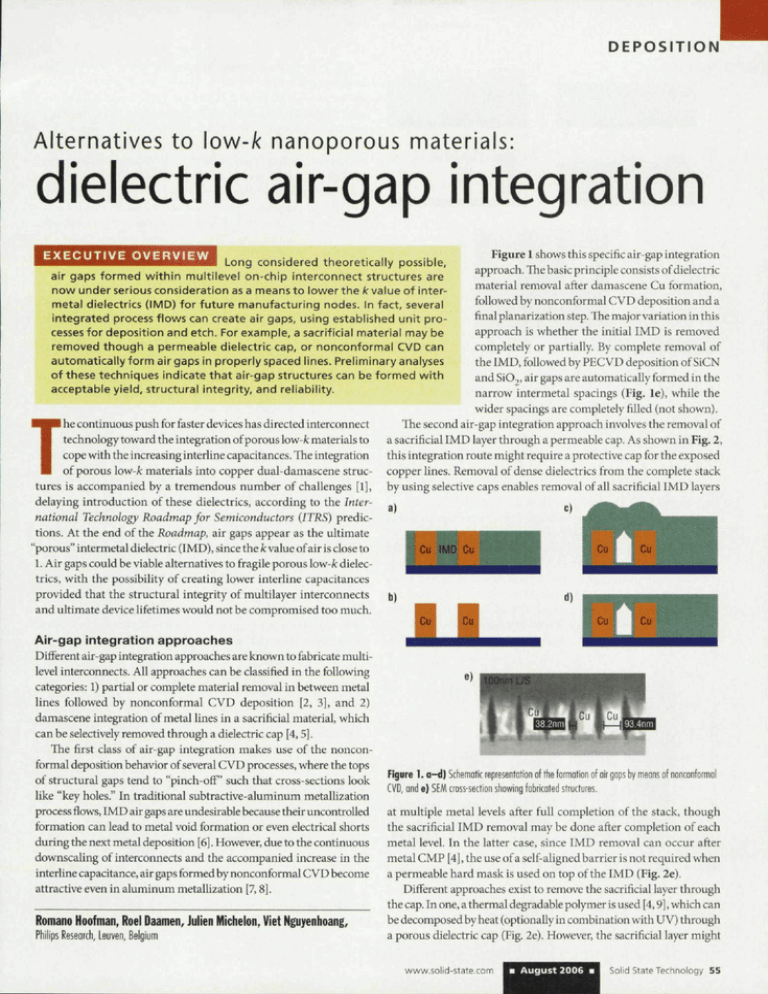dielectric air-gap integration \o\N-k DEPOSITION
advertisement

DEPOSITION
Alternatives to \o\N-k nanoporous materials:
dielectric air-gap integration
EXECUTIVE OVERVIEW
Figure 1 shows this specific air-gap integration
approach. The basic principle consists of dielectric
material removal after damascene Cu formation,
followed by nonconformal CVD deposition and a
final planarization step. The major variation in this
approach is whether the initial IMD is removed
completely or partially. By complete removal of
the IMD, followed by PECVD deposition of SiCN
and SiO2, air gaps are automatically formed in the
narrow intermeta! spacings (Fig. le), while the
wider spacings are completely filled (not shown).
The second air-gap integration approach involves the removal of
asacrificiallMDlayerthroughapermeablecap. AssbowninFig. 2,
this integration route might require a protective cap for the exposed
copper lines. Removal of dense dielectrics from the complete stack
by using selective caps enables removal of all sacrificial IMD layers
Long considered theoretically possible,
air gaps formed within multilevel on-chip interconnect structures are
now under serious consideration as a means to iowerthe lvalue of intermetal dielectrics (IMD) for future manufacturing nodes. In fact, several
integrated process flows can create air gaps, using established unit processes for deposition and etch. For example, a sacrificial material may be
removed though a permeable dielectric cap, or nonconformal CVD can
automatically form air gaps in properly spaced lines. Preliminary analyses
of these techniques indicate that air-gap structures can be formed with
acceptable yield, structural integrity, and reliability.
T
he continuous push for faster devices has directed interconnect
technology toward the integration of porous \ow-k materials to
cope with the increasing interline capacitances. The integration
of porous low-/: materials into copper dual-damascene structures is accompanied by a tremendous number of challenges [1],
delaying introduction of these dielectrics, according to the International Technology Roadmap for Semiconductors {ITRS) predictions. At the end of the Roadmap, air gaps appear as the ultimate
"porous" intermetal dielectric (IMD), since the k value of air is close to
1. Air gaps could be viable alternatives to fragile porous \ow-k dielectrics, with the possibility of creating lower interline capacitances
provided that the structural integrity of muhilayer interconnects
and ultimate device lifetimes would not be compromised too much.
Cu I M D Cu
b)
iJ)
Air-gap integration approaches
Different air-gap integration approaches are known to fabricate multilevel interconnects. All approaches can be classified in the following
categories: 1) partial or complete material removal in between metal
lines followed by nonconformal CVD deposition [2, 3], and 2)
damascene integration of metal lines in a sacrificial material, which
can be selectively removed through a dielectric cap [4,5].
The first class of air-gap integration makes use of tbe nonconformal deposition hehavior of several CVD processes, w4iere the tops
of structural gaps tend to "pinch-ofF' such that cross-sections look
like "key holes." In traditional subtractive-aluminum metallization
processflows,IMD air gaps are undesirable because their uncontrolled
formation can lead to metal void formation or even electrical shorts
during the next metal deposition [6]. However, due to the continuous
downscaling of interconnects and the accompanied increase in the
interline capacitance, air gaps formed by nonconformal CVD become
attractive even in aluminum metallization [7,8].
Romano Hoofman, Roel Daamen, Julien Micheton, Viet Nguyenhoang,
Philips Research, leuven, Belgium
Figure 1. a - d ) Schemotic representotior of the formation of air gaps by means af rarmnformal
CVD, ond e) SEM crass-section shewing fobricated structures.
at multiple metal levels after full completion ofthe stack, though
the sacrificial IMD removal may be done after completion of each
metal level. In the latter case, since IMD removal can occur after
metal CMP [4], the use of a self-aligned barrier is not required when
a permeable hard mask is used on top ofthe IMD (Fig. 2e).
Different approaches exist to remove the sacrificial layer through
the cap. In one, a thermal degradable polymer is used [4,9], which can
be decomposed by heat (optionally in combination with UV) through
a porous dielectric cap (Fig. 2e). However, the sacrificial layer might
www.solid-state.corn
August 2006 •
Solid State Technology 55
in Fig. 3 due to the fringing capacitances through the pre-metal
dielectric and bottom SiC liner. Even structure B, using a porous
low-^ material with a hulk 2.4 k and a SiC(N)-cap with 4.0 k is barely
able to meet the requirements. The only architectures where fc jr is
below 2.6 for both Ml and M2 are achieved using air gaps.
The nonconformal CVD approach gets most of its gain through
reduction of the fringing capacitance due to the gap extension above
and below the IMD level. A further decrease might be possible by
complete material removal combined with extreme nonconformal
CVD [11]. The sacrificial approaches have the biggest gains, since they
benefit from the removal of dielectric from the complete IMD width.
a)
b)
Mechanical integrity
Figure 2 . a - d ) Schemotit representolior ot the formction ot air gops by selective IMD removal
ttiiough • dielectric cap, and e) SEM cross-section showing tnbricnted structures.
also be removed by selective {wet or dry) etching through the cap.
System-level considerations
The interconnect performance can be benchmarked using the RCproduct of different interconnect architectures. For low-power applications, the interconnect capacitance (C) is more important than
interconnect resistance (R) from a system perspective [10], so air
gaps are especially interesting for these kinds of systems.
A commercial interconnect analysis software package (Raphael)
was used to simulate thefc^^for air-gap architectures consisting of
two metal levels at 45nm technology node dimensions (Fig. 3). For
structure D using nonconformal CVD, the width of the air-gap cavity
is assumed to be 30nm and to extend 20nm above the Cu lines, while
the air-gap cavity at IMD2 extends 50nm into the ILDl level. For
structure F using sacrificial material, 75% of the IMDl and IMD2
thickness is composed of air gaps, with 90% for structure H.
Thefcp^at Ml is somewhat higher than at M2 for all structures
Metal 1
45nm target
= 2.6
Figure 3 . Simuloted ettective dielectric constants ik^^) tor vorious twa-metal-level interconnect
arctiitecfures at tlie 45nm node tor A) dense low-it, B) porous low-il;, D) CVD pinch-ott air gaps,
and F-H) sacriticiol removal air gaps. At Ml, L/S = 65/65nm, IMD = 140nni ttiick, via diameter
= 70nni, 105nrTi deep, far M2, L/S - 80//0nm and ILO ^ 170nm thick.
56 Solid State Technology
m August 2006
www.soiJd-state,com
One of the biggest concerns with respect to the introduction of air gaps
in interconnects is the mechanical integrity of the entire stack. Due to
weaker mechanical properties of the dielectric materials, packaging
process steps such as wire bonding and molding might induce cracks
inside the IC stack and therefore create electrical failures in the short
or longer term. Good mechanical properties of the stack are therefore
essential for chip survival during packaging [12].
With sacrificial-material air gaps, the mechanical strength of the
stack is solely determined by the metal and other cap/barrier dielectrics.
Exact placement of the air gaps in specific locations on each metal level
is therefore of great importance and will determine the mechanical
Integrity of air-gap interconnects. The mechanical integrity can also
be enhanced by the use of an additional mask to prevent dielectric
removal in noncritical areas of medium or large line spacing.
The mechanical integrity is less problematic for the nonconformal
CVD approaches compared to the sacrificial material approaches, since
the CVD dielectric contributes to the mechanical strength of the stack
in wide spaces. Regardless of the approach, the mechanical strength
of air-gap layers depends on the placement of metal structures. For airgap integration, a design trade-off is needed between minimal routingarea (functionality-aware design) and sufficient metal density to ensure
good mechanical strength of the entire stack (air-gap-driven design).
Some applications do not require many air-gap metal layers; the
incorporation of one air-gap level might be sufficient for the required
performance boost and/or power reduction. From \ow-k packaging
experiments, it is well known that most of the failures occur in the
top levels. Therefore, one could opt for only a few air-gap layers at
the lowest metal levels.
Reliability challenges
In addition to challenges related to mechanical integrity, concerns
exist that air gaps might give rise to long-term reliability problems.
Device lifetimes could theoretically be reduced due to electromigration failures and degraded barriers.
Via reliability. Unlanded vias are major concerns in air-gap
integration, since the potential misalignment of line and via levels
could allow via etch to open a pathway to an air gap. Wet chemicals
could then remain trapped inside the air gap and cause long-term
barrier corrosion. Moreover, a thin metallic barrier can never close
this undesired pathway, resulting in a barrier discontinuity.
For most air-gap architectures, the unianded via issue can be
overcome by using more space for the via landing. This space can
either be a copper landing pad or a dense dielectric that has not heen
continued on page 58
I Dielectric air-gap integration continued from page 56
removed prior to air-gap formation. However,
the drawback of this solution is that the extra
space takes up routing area.
For the nonconformal CVD approaches.
the deposited dielectric on the sidewail
(before pinch-off) provides some margin for
via landing. This may not be a scalable option,
however, since the thickness of sidewall
dielectric decreases as the dielectric spacing is
scaled down. For sacrificial material approaches,
fewer issues are expected with unlanded vias
since the sacrificial material is not yet removed
at the stage of via etch in most cases.
10yr@0.1MV/cm
Conclusion
Two different air-gap integration approaches
Pristine
were investigated in detail. Thefirstclass uses
Air gaps after
air gaps
sacrificial materials, which are selectively
\extended bake
removed through a capping layer either by
wet- or dry-etching or by thermal decomposition. The second class uses the nonconformal deposition of different CVD layers,
which creates air gaps for narrow spaced
0
1
2
3
4
lines. All approaches show significant IC
Electric field (MV/cm)
performance increases through capacitance
reduction. Interconnects containing air
Figure 4 . Failure times versjs electric tield tor a 150nm oitEIectromigration.Hau-Riegeetal. [13] stated gap space (tor pristine samples and tor somples thot received
gaps do not show more reliahility challenges
that copper embedded in low elastic modulus an extended bake priar to TDDB measurements).
than interconnects with porous low-/:
materials would result in shorter electromidielectrics. Therefore, air-gap technology is
gration (EM) lifetimes due to the lower "back stress" of the surrounding a viable option for the 32nm node and beyond.
•
material. Since air gaps have little or no material to provide support, the
entire back stress has to come from the metallic barrier. Consequently. Acknowledgments
EM lifetimes would theoreticallydecrease with thinning of the metallic
Raphael is a trademark of Synopsys Corp.
barrier, leading to another potential scalability issue.
From work on air gaps formed by nonconformal CVD in between
aluminum lines [14], it is known tbat the EM lifetimes of air-gap
structures (especially for the case of narrow and high aspect-ratio
lines) are significantly higher than for solid gap-filled interconnects.
Failure analysis and simulation results indicated that the compliant
sidewall of the air gap is able to deform and relieve the stress during
metal depletion. Copper/air-gap interconnect structures formed by
nonconformal CVD show no significant difference in lifetimes as
compared to dense references [2]; no new failure modes, such as
metal extrusion between the lines, were observed.
For sacrificial-material air gaps, the situation is expected to be the
same or worse, since no dielectric exists to support the metallic harrier
at the sidewalls. However, first preliminary EM experiments using
packaged samples on 200nm wide lines surrounded by 250nm wide
air gaps gave promising lifetimes with a MT^T'F of 228 years and a 0.01%
failure after 6.5 years [4]. SEM inspections after EM tests have revealed
two types of damage: void formation near the cathode side, and copper
extrusions in the second part of the line. Nevertheless, the EM lifetime
does not seem to be affected too much by the fact that the metal lines are
embedded in a mechanically weak material (or no material at all).
Interline leakage and air-gap breakdown. For nonconformal
CVD air gaps, leakage current and shorts were found not to be
problematic by Noguchi et al. [15]. They demonstrated that the
time-dependent breakdown (TDDB) of nonconformal CVD air gaps
considerably outperformed that of interconnect using conventional
FSG dielectric. The leakage current of the air gaps was found to be
lower than that of FSC at high voltage, probably because the trapassisted conduction mechanism is hampered. Short cuts between
adjacent lines occur less frequently since metallic residues in between
the lines will be removed during the gap etch.
However, it should be mentioned that leakage, breakdown strength,
and especially TDDB are extremely sensitive to moisture inside the gaps.
Figure 4 shows that TDDB lifetimes can be considerably improved if
moisture is removed from the inside of the integrated structures by
a bake step. Therefore, moisture should be kept out of interconnect
structures containing either low k or air gaps.
58 Solid State Technology
August 2006
www.solid-5tate.com
References
1. R.|.O.M. Hootman, G.J.A.M. Verheijden,). Michelon, F. lacopi, Y. Travaly,
M.R. Baklanov, et al., Microeieclron. Erjg. 80. pp. 337-344,2005.
2. V. Arnal, |. Torres, P. Gayet, R. Gonella. P. Spinelli, M. Guitlermet. et al.,
Proi: IITC, pp. 298-300,2001.
3.1.P. Gueneautie Mussy, C. Bruynsereade, Z. Tokei, G.P. Beyer, K. Maex, Proc.
//rC, pp. 150-152,2005.
4. R. Daamen, G.J.A.M. Verheijden, P.H.L. Bancken, T. Vandeweyer, |. Michelon, V. Nguyen Hoang, et al., Proc. IITC, pp. 240-242.2005.
5. L.G. Cosset, A. Farcy, J. de Pontcharra, Ph. Lyan, R. Daamen, G.J.A.M. Verheijden, et al.. Microelectronic Engineering 82, pp. 321-332, 2005.
6. D.R. Cote, S.V. Nguyen, W.|. Cote, S.L. Pennington. A.K. Stamper, D.V. Pcdlesnik, IBM /. Res. Develop. 39, pp. 437-464, 1995.
7. B.P. Shieh, L.C. Bassman, D.-K. Kim, K.C. Saraswat, M.D. Deal, |.P. McVittie, et al., Proc. IITC, pp. 125-127, 1998.
8. T. Ueda, B. Tamaoka, K. Yamashita, N. Aoi, S. Mayumi, Proc. VLSI Symp...
pp. 46-47,1998.
9. RA. Kohl, D.M. Bhusari. M. Wedlake, C. Case, F.P. Klemens, f. Miner, et al.,
IEEE Electron Dev- Lett- 21, pp. 557-559, 2000.
10. V.H. Nguyen, P Christie, A. Heringa, A. Kumar, R. Ng, Proc. IITC, pp.
191-193,2005.
11. A. Stich, Z. Gabric, W. Pamler, Microetectron. Eng. 82, pp. 362-367, 2005.
12. L.L. Mercado, C. Goldberg, S.M. Kuo, T.Y. Lee, S.K. Pozder, IEEE Trans.
Dev. Mater. Reliab. 3, pp. 111-118, 2003.
13. C.S. Hau-Riege, S.P. Hau-Riege, A.P. Marathe, /. Appt. Phys. 96, pp. 57925796, 2004.
14 B.P. Shieh, M.D. Deal, K.C. Saraswat, R. Choudhury, C-W. Park, V. Sukharev,
Proc. IITC, pp. 203-205,2002.
15.1. Noguchi. K. Sato. N. Konishi, S. Uno, T. Oshima, K. Ishikawa,/£££ Trans.
Electron Dev. 52. pp. 352-359.2005.
ROMANO //oOFMAivieads interconnect research focusing on the 32nm
node at Philips Research, Kapeldreef 75, Leuven BSOOl, Belgium; ph
32/0-16-288309; e-mail romano.hoofman@philips.com.
ROEL DAAMEN works on alternative FEOL and BEOL CMP
techniques at Philips Research.
MICHELON works on advanced Cu/low-fc interconnect
reliability at Philips Research.
VIET NGUYENHOANG
Philips Research.
researches on-chip interconnect systems at




